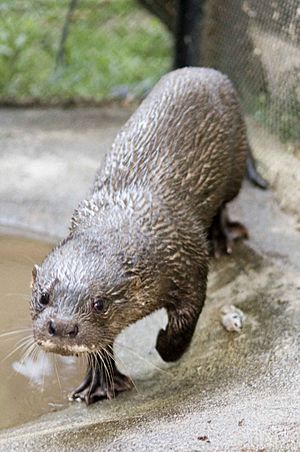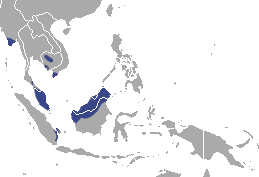Hairy-nosed otter facts for kids
Quick facts for kids Hairy-nosed otter |
|
|---|---|
 |
|
| in Cambodia | |
| Conservation status | |
| Scientific classification | |
| Genus: |
Lutra
|
| Species: |
sumatrana
|
 |
|
| Hairy-nosed otter range | |
The hairy-nosed otter (Lutra sumatrana) is a special type of otter. It lives only in parts of Southeast Asia. This otter is currently in danger of disappearing. Its biggest threats are losing its home and illegal hunting, known as poaching.
Contents
What is a Hairy-Nosed Otter?
The hairy-nosed otter gets its name from the soft, velvety fur on its nose. This makes it different from other otter species. It has a sleek, dark brown body and a long, strong tail. Its webbed feet help it swim very well. These otters can grow to about 1.3 meters (4.3 feet) long, including their tail. They usually weigh around 7 to 8 kilograms (15 to 18 pounds).
How to Identify Them?
Besides their unique nose, hairy-nosed otters have other features. Their fur is often darker than other otters. They also have a distinct shape to their head. Scientists can tell them apart by looking closely at these details. Sometimes, it's hard to spot them in the wild.
Where Do Hairy-Nosed Otters Live?
Hairy-nosed otters live in tropical and subtropical areas. Their home is in Southeast Asia. This includes countries like Cambodia, Malaysia, Indonesia, and Thailand. They prefer freshwater habitats. These can be rivers, swamps, and flooded forests. They need clean water and plenty of hiding spots.
Their Preferred Habitat
These otters love areas with dense plants along the water's edge. This vegetation provides cover from predators. It also offers good places to build their dens. They often live near slow-moving rivers or lakes. Sometimes, they are found in coastal areas too.
What Do Hairy-Nosed Otters Eat?
Hairy-nosed otters are carnivores, meaning they eat meat. Their diet mainly consists of fish. They are excellent hunters in the water. They use their strong bodies and sharp teeth to catch prey.
Their Diet and Hunting Habits
Besides fish, they also eat other small animals. This can include frogs, crabs, and even small reptiles. They hunt mostly at night. Their sensitive whiskers help them find food in murky water. They are very skilled at diving and swimming quickly.
Why Are Hairy-Nosed Otters Endangered?
The hairy-nosed otter is listed as an endangered species. This means their numbers are very low. They face serious threats that put their survival at risk. These threats are mostly caused by human activities.
Loss of Habitat
One major problem is the loss of their natural home. Forests are being cut down for farming and development. Wetlands are drained for human use. This destroys the rivers and swamps where otters live. When their habitat shrinks, they have less space to find food and raise their young.
Threats from Poaching
Another big threat is poaching. Poaching is the illegal hunting of animals. Hairy-nosed otters are hunted for their fur. They are also sometimes caught for the illegal pet trade. This illegal activity reduces their population numbers quickly.
Other Dangers
Pollution also harms these otters. Chemicals from farms and factories can contaminate rivers. This makes the water unsafe for otters and their food. Fishing nets can also accidentally trap and drown otters.
Conservation Efforts
Many groups are working to protect the hairy-nosed otter. They are trying to save their habitats. They also work to stop poaching. Protecting these otters helps protect the entire ecosystem.
How People Are Helping
Conservationists are setting up protected areas. These areas keep the otters' homes safe. They also educate local communities about the importance of otters. Stopping illegal hunting is a key part of these efforts. By working together, we can help these amazing animals survive.
Images for kids
See also
 In Spanish: Nutria de Sumatra para niños
In Spanish: Nutria de Sumatra para niños




